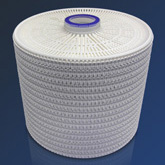Introduction
Stacked disc modules have a long history in Food and Beverage applications. They arose out of the need to package sheet-based depth filter technology in more user-friendly, modular closed systems, especially for small batch production or medium flow rate applications. Due to the relative high dirt holding capacity and filtration performance of filter sheet-based products, they provided an optimal and cost-effective solution for handling food and beverage fluids.
The filtration effect of these sheet-based products is based on a combination of surface, depth, and adsorptive filtration. Selected combinations of cellulose, different types of filter aids, or other ingredients in the filter matrix result in a highly porous structure, which achieves effective filtration, including coarse to fine particle removal, colloidal removal, and final filtration.
Classic stacked disc modules represent first generation module design, but they have performance disadvantages.
SUPRAdisc II modules eliminate the disadvantages of classic stacked disc modules. They offer increased capacity, reliability, handling advantages, and robustness, which satisfies customer needs and requirements for a higher performing product.
SUPRAdisc II modules are ideal for many food and beverage applications.
Basic construction of classic stacked disc modules
To better appreciate the design advancements of SUPRAdisc II filter modules, an understanding of the basic features and construction of stacked disc modules should be considered.
Since their inception, classic stacked disc modules have been manufactured leaving the cells of media fully exposed within the filter housing (Figures 1 and 2).
- Individual cells are made from two sheets of depth filter media with a polypropylene separator in between them. This separator is sandwiched inside the cell, on the downstream side of the two sheets, as the flow path is from the outside surface of the sheets to the inside (Figure 3).
- A polypropylene seal around the outside edge is used to bind the two sheets together, thus forming one complete cell.
- The cells are stacked on top of each other until the desired height is achieved.
- End caps are then affixed to the center core, thus locking each cell in place and forming a complete stacked disc module.
Design limitations of classic stacked disc modules
Classic stacked disc modules have inherent design limitations.
- Depth media is exposed
- The integrity of the media can be compromised during shipping, handling, installation and removal. Extra care must be taken to avoid damage.
- Modules can fall apart when removed from the housing.
- Individual cell proximity to one another is very close. During steaming, rinsing, or filtration, the cells may shift or warp causing individual cells to touch. This causes blinding of portions of each cell, which reduces the effective filtration area.
- Classic stacked disc designs do not withstand any back pressure. With only the downstream support layer (the separator), even as little as 0.05 bar (0.7 psid) of back pressure can rupture the unsupported media in these modules. This is seen as a half moon tear on either the top sheet of the top module or the bottom sheet of the lowest module in the stack, creating fluid bypass areas and compromising filtrate quality.
- Classic stacked disc modules are sensitive to high temperature operations such as hot water sanitization, steaming, or hot filtration. Deformation caused by high temperature exposure is a common problem (Figure 4).
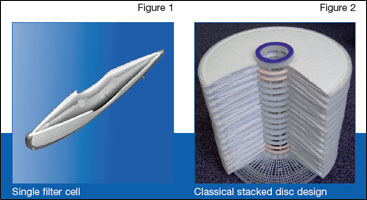
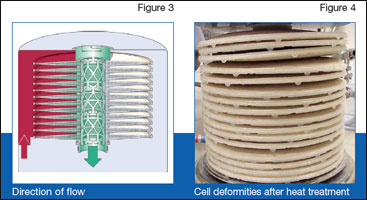
Construction technology of SUPRAdisc II modules
SUPRAdisc II modules (Figure 5) incorporate a double separator concept.
- Alternating outside separators, discs of depth media, and inside separators are affixed to a rigid polypropylene core until the desired height is achieved.
- Two techniques are used to connect the separators:
- For 287 mm (12 inch) diameter modules, the unique Clip-Seal Interlock is created by using a hydraulic ram to apply pressure and snap and lock the outside to the inside separators. Each disc of filter media is thus sealed in between the separators.
- For 410 mm (16 inch) diameter modules, the inside/outside separators are connected by ultrasonic welding.
- Locking end caps are then applied to the center core, creating a complete module.
Design features of SUPRAdisc II modules
The unique separator design provides both upstream and downstream support of the filter media. The media is sealed inside a polypropylene cage assembly and is no longer exposed. The unique Clip-Seal Interlock and the welded design connects the outside to the inside separators resulting in an extremely robust design (Figures 6,7).
Each sheet of filtration media is individually sealed and separated. Depth sheets cannot come into contact with each other, eliminating blinding of the media.
Due to the separator channels, SUPRAdisc II modules have close to 100 % effective filtration area that is dimensionally stable during shipment and handling, filtration and removal.
Deformation or cell collapse is no longer an issue and sheet damage during use is minimized. Backflushing to regenerate the modules is now possible.
Backflushing SUPRAdisc II modules
With the use of a backflush set consisting of supporting discs and intermediate distance discs (Figure 8), modules can be backflushed either with water or product in order to remove contaminants and prolong their life.
For more detailed information on backflushing and availability of backflush sets, please contact Pall.
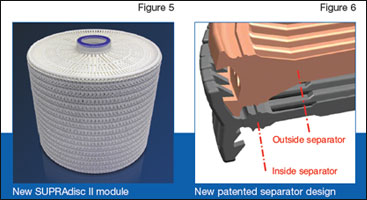
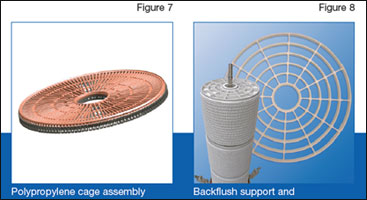
Benefits of SUPRAdisc II modules
SUPRAdisc II modules offer a multitude of benefits that overcome the disadvantages of the classical stacked disc design (Figures 9, 10, 11). These benefits result in important cost savings.
- Longer onstream life, due to highest utilization of the filter sheet area, no blinding of filter surfaces, open design of the separators, optimized drainage, and distribution of incoming fluid to each filter sheet via the outside separator
- Repeated use is possible due to regenerability of the modules with backflushing
- Higher operational security, due to resilience against vacuum or back pressure shocks, and no cell or module deformation from hot operation or sanitization and steaming
- Better handling before and after operation, due to robust design and protection of filter media from exposure and damage
- Higher yields, as rest filtration in reverse flow mode is possible
- High filtrate quality, without chance of bypass, due to module design and use of proven and reliable filter media recipes
SUPRAdisc housings
SUPRAdisc II modules are used in SUPRAdisc housings. Up to 4 modules can be stacked in a housing without concern of deformation or loss of module integrity. This is due to the solid design of the inner tubular core. This center core is capable of carrying the load of the saturated wet weight of the modules, minimizing the compressive forces on individual filter cells, and subsequently the filter sheets.
For further technical and ordering information on Pall SUPRAdisc housings, please consult Pall.
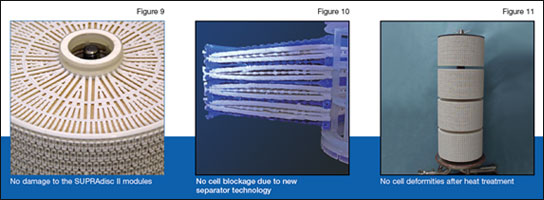
SUPRAdisc II Module Types
Standard Range
Available in 287 mm (12 inch) and 410 mm (16 inch) diameters, SUPRAdisc II Standard Range modules contain single layer Pall filter sheet media, in K, T, and IR grades (Figure 12).
HP Range
Available only in 410 mm (16 inch) diameter, the SUPRAdisc II HP Range combines 2 different grades of Pall filter sheet media into a single module. A coarse layer on the upstream side and a fine layer on the downstream side allows pre-clarification and clarification in one assembly. Each of the sheet layers is separated by a separator (Figures 13, 14).
A wide range of upstream and downstream sheet combinations is available.
SUPRAdisc II HP modules are not designed for backflushing.
Benefits of SUPRAdisc II HP modules
- Enhanced clarification abilities for fluids with wide particle size distribution, due to graded particle removal. Larger particles are retained by the top sheet layer, thus avoiding plugging of the finer sheet material below. In turn, the downstream layer enables increased efficiency of the upstream layer.
- Up to 30 % higher filtration efficiency than in single layer formats
- Reduced capital expenditure for small batch processing, due to two-step filtration in one housing
- Reduced rinsing water and cleaning chemical consumption
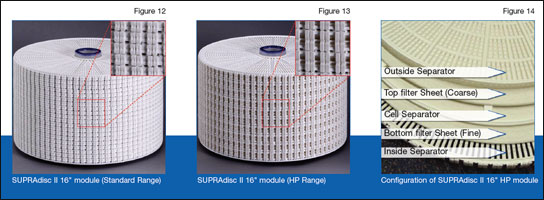
- Particle Removal
- Polishing Filtration
- Final Filtration
Spirits
- Particle Removal
- Chill Haze Removal
- Bottling Filtration
Wine
- Particle Removal
- Polishing Filtration
- Filtration after Stabilization
- Pre-filtration prior to Final Membrane Filters
Sparkling Wine
- Particle Removal
- Polishing Filtration
- Filtration after Stabilization
- Pre-filtration prior to Final Membrane Filters
Fruit Juice
- Particle Removal
- Polishing Filtration
- Filtration after Stabilization
- Pre-filtration prior to Final Membrane Filters
- Reduction of Alicyclobacillus Acidoterrestris
Sweeteners and Gelatin
- Particle Removal
- Polishing Filtration
- Final Filtration
SUPRAdisc II filter media options
K Series
With 13 different grades of permeability, the K Series modules represent Pall's standard depth filter series. These sheets consist of a cellulose matrix with very fine kieselguhr (diatomaceous earth or DE) mixtures and perlite, as filtration-active substances.
Table 1: Removal performance of K Series Modules| Sheet Media Type | Application | Examples of use |
| EKS, EK1, EK, KS 50, KS 80 |
Fine Filtration | Microorganism reduction and yeast removal in wine Microorganism reduction in beer with moderate to high microbial load Final filtration of juice and juice concentrate prior to bottling Microorganism reduction in sugar syrups Microorganism reduction in enzyme solutions |
| K100, K150, K200, K250, K300 |
Polishing Filtration |
Polishing filtration of wine Microorganism reduction in beer with low microbial load Fine filtration of beer and yeast removal Fine filtration of beer following DE prefiltration Polishing filtration of beer Prefiltration of juice prior to final membrane filtration Haze removal in apple juice before bottling Polishing filtration of sugar syrups Polishing filtration of enzyme solutions Polishing filtration of thick liquor gelatine Secondary sedimentation prevention in tea |
| K700, K800, K900 | Coarse Filtration |
Clarification of wine Particle removal in fruit juice Particle removal in tea-based beverages Prefiltration of juice concentrate Polishing filtration of olive oil Clarification of enzyme solutions Clarification of thin liquor gelatine |
These modules are used for a wide range of very fine to coarse filtration in many food and beverage applications.
SUPRAdisc II filter media options
T Series
The T Series modules include 7 different grades of permeability. Some types consist of a mixture of cellulose and the filtration-active substance perlite, while others consist of pure cellulose.
Table 2: Removal performance of T Series Modules| Sheet Media Type | Application | Examples of use |
| T950, T1000, T1500 | Coarse Filtration | Wine clarification Coarse filtration of natural extracts |
| T2100, T2600, T3500, T5500 | Coarse Filtration | Roughing filtration of spirits Clarification of enzyme solutions |
These modules are designed for general purpose coarse filtration, as they are characterized by a loose structure with high particle load capacity.
They also prove to be very successful in filtering viscous fluids, and retaining gel particles or coarsely dispersed components.
IR Series
The IR Series modules include 4 grades of permeability. They are optimal for ion-sensitive applications. Due to a proprietary manufacturing process, they release minimum levels of calcium and magnesium, and negligible levels of iron and copper to the filtered product.
Table 3: Removal performance of IR Series Modules
| Sheet Media Type | Application | Examples of use |
| KS50IR | Fine Filtration | Polishing filtration of white spirits |
| K100IR, K250IR | Polishing Filtration | Polishing filtration of white spirits Chill haze removal in brown spirits |
| K800IR | Coarse Filtration | Chill haze removal in brown spirits |
IR modules are uniquely suited to filtering distilled spirits, providing a visually bright finished product. In spirits, calcium and magnesium precipitates in the form of sulphate or carbonate compounds often result in particulate turbidity. Pall IR modules reduce the danger of precipitate formation due to their extremely low content of extractables.
The particulate turbidity in spirits often contributes to chill haze caused by esters of the higher fatty acids (C12-C16 chains). In such cases, IR filter sheets distinguish themselves by their selective adsorption capacity that can be used for specific separation of medium to long chain fatty acid esters. The short chain fatty acid esters, which are important for creating the aroma in spirits, are not negatively affected by the removal performance of these modules.
Select the language below:
| SUPRAdisc™ II Depth Filter Modules Installation - English |
| SUPRAdisc™ II Depth Filter Modules - English |
SUPRAdisc II Standard Range
This is a guide to the Part Numbering structure only. For specific options, please contact Pall
Part Number:
200 [Table 1] [Table 2] [Table 3] [Table 4] [Table 5] W
Example Part Number:
200 X100 C 232 S P W
See bold reference codes in tables
Table 1
| Code | Sheet Media Type |
| K Series | |
| XEKS | EKS |
| XEK1 | EK1 |
| XEKO | EK |
| X050 | KS50 |
| X080 | KS80 |
| X100 | K100 |
| X150 | K150 |
| X200 | K200 |
| X250 | K250 |
| X300 | K300 |
| X700 | K700 |
| X800 | K800 |
| X900 | K900 |
| IR Series | |
| C050 | KS50IR |
| C100 | K100IR |
| C250 | K250IR |
| C800 | K800IR |
| T Series | |
| T950 | T950 |
| T100 | T1000 |
| T150 | T1500 |
| T210 | T2100 |
| T260 | T2600 |
| T350 | T3500 |
| T550 | T5500 |
Table 2
| Code | Adapter | Nominal Height |
| C | Flat gasket | 272 mm (10.7 in) |
Table 3
| Code | Nominal Diameter | Number of Sheets | Area |
| 232 | 287 mm (12 in) | 32 | 1.8 m2 (19.4 ft2) |
| 440 | 410 mm (16 in) | 40 | 5 m2 (54 ft2) |
Alternative module dimensions are available on request.
Table 4
| Code | O-ring Seal Options |
| S | Silicone (standard) |
| E | EPDM |
Seal materials meet FDA requirements for food contact use detailed in 21 CFR Section 177.2600. Alternative materials are available on request.
Table 5
| Code | Cage Assembly |
| P | Polypropylene |
SUPRAdisc II HP Range
This is a guide to the Part Numbering structure only. For specific options, please contact Pall
Part Number:
200 [Table 1] D [Table 2] [Table 3] [Table 4] [Table 5] [Table 6] W
Example Part Number: 200 X D L6 C 420 S P W
See bold reference codes in tables
Table 1
| Code | O-ring Seal Options |
| X | K Series |
| C | IR Series |
Table 2
| Code | Sheet Media Combination | |
| Top Sheet Prefilter |
Bottom Sheet Fine Filter |
|
| K Series | ||
| O7 | K900 | K150 |
| O8 | K900 | K200 |
| N6 | K800 | K100 |
| N7 | K800 | K150 |
| M5 | K700 | KS80 |
| M6 | K700 | K100 |
| L4 | K300 | KS50 |
| L5 | K300 | KS80 |
| L6 | K300 | K100 |
| L7 | K300 | K150 |
| K3 | K250 | EK |
| K4 | K250 | KS50 |
| H2 | K200 | EK1 |
| H3 | K200 | EK |
| H5 | K200 | KS80 |
| G1 | K150 | EKS |
| G2 | K150 | EK1 |
| G5 | K150 | KS80 |
| F1 | K100 | EKS |
| F3 | K100 | EK |
| IR Series | ||
| N4 | K800IR | KS50IR |
| N6 | K800IR | K100IR |
| N9 | K800IR | K250IR |
| K4 | K250IR | KS50IR |
| K6 | K250IR | K100IR |
| F4 | K100IR | KS50IR |
For alternative combinations, contact Pall.
Table 3
| Code | Adapter | Nominal Height |
| C | Flat gasket | 272 mm (10.7 in) |
Table 4
| Code | Nominal Diameter | Number of Double Layers | Area |
| 420 | 410 mm (16 in) | 20 | 2.5 m2 (27 ft2) |
Alternative module dimensions are available on request.
Table 5
| Code | O-ring Seal Options |
| S | Silicone (standard) |
| E | EPDM |
Seal materials meet FDA requirements for food contact use detailed in 21 CFR Section 177.2600. Alternative materials are available on request.
Table 6
| Code | Cage Assembly |
| P | Polypropylene |
Earn 10% off* your next order online by leaving a review of this product. Please login to your account to leave a review. We appreciate and value your feedback.
*Subject to Terms and Conditions.



